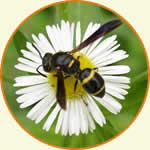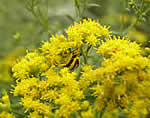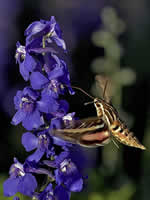USDA Forest Service Celebrating Wildflowers
|
|
|
Insect Basics
Six legs, three body parts (HEAD, THORAX, and ABDOMEN), a hard EXOSKELETON, and compound eyes characterize insects. Most insects have a pair of antennae and two pairs of wings. Insects grow by MOLTING, shedding their old exoskeleton, and growing a new, roomier one. After molting, and before the new exoskeleton hardens, insect bodies are soft and vulnerable. Insects go through COMPLETE METAMORPHOSIS. Life cycle stages are EGG, LARVA, PUPA, and ADULT. Butterflies, bees and beetles are insects whose larval forms are distinctly different from the adult form. Insects whose larval form resembles the adult, such as crickets and cockroaches, go through INCOMPLETE METAMORPHOSIS. Spiders are NOT insects, but like insects and are arthropods (jointed legs, hard outer layer). They have eight legs, compound eyes and an exoskeleton. Some spiders have defensive URTICATING HAIRS which when thrown temporarily blind a predator’s eyes. BehaviorInsects can be HERBIVORES or CARNIVORES, and some are PESTS to humans. Mosquitoes feed on mammalian blood, aphids and scale insects infest our gardens, and wasps produce a nasty sting. Most insects are BENEFICIAL. Bees, beetles, and butterflies POLLINATE our gardens and crops, making possible such foods as chocolate, nuts, and most fruits. Some insects are DECOMPOSERS, helping to breakdown dead material. Other insects, like ladybugs and praying mantis, feed on pest insects. Flowers have adapted various attributes (COLOR, SCENT, SHAPE, SIZE) to attract specific pollinators such as bees, butterflies, and hummingbirds. See pollinator syndromes for more information. These pollinators sip NECTAR from the flower, collect POLLEN and carry this pollen to the next flower of the same species (or in some cases, the pollinator moves the pollen within the same flower), thus fertilizing the flower. |
|
| NOTE: PDF format links require the Adobe Acrobat Reader to view. | |
| top | Disclaimers | FOIA | Privacy Policy | Quality of Information | Photo Credits & Use |
Location: http://www.fs.fed.us/wildflowers/pollinators/insectbasics.shtml
Last modified: Tuesday, 20-May-2008 15:56:18 EDT



